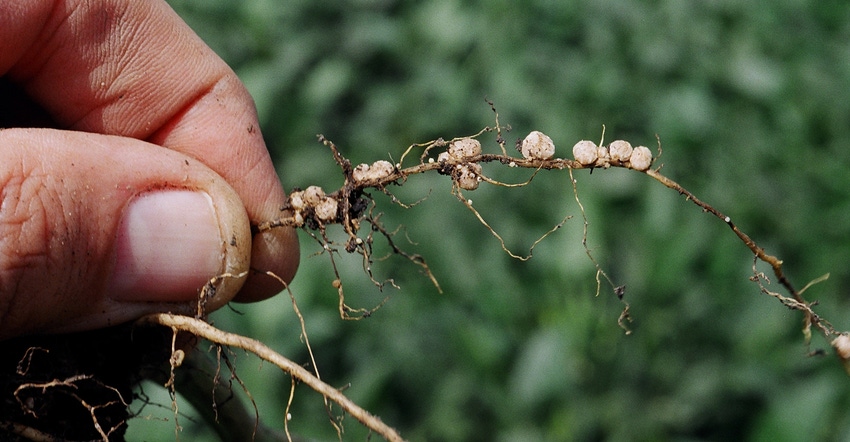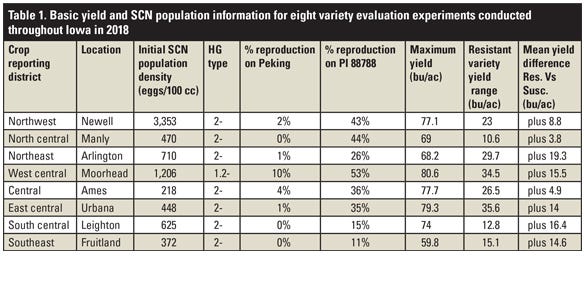January 11, 2019

Iowa State University annually evaluates the agronomic performance and nematode control of hundreds of soybean varieties that are resistant to soybean cyst nematode. A limited number of SCN-susceptible soybean varieties are included in the research to serve as a reference point for comparison.
The work is supported by the soybean checkoff through the Iowa Soybean Association. The experiments are conducted in each of Iowa’s nine crop reporting districts.
The results of the experiments conducted in 2018 were compiled in a report that is available online. A summary of the basic information about yields and SCN populations for eight of the nine experiments conducted in 2018 is given in the table. One of the experiments, in southwest Iowa, was not harvested because of wet soil conditions.

Greg Tylka, ISU Extension nematologist, provides the following interpretation and information of the 2018 test results. As a professor in the ISU department of plant pathology, he has Extension and research responsibilities for management of plant-parasitic nematodes.
SCN has high reproduction on PI 88788
Test results with low SCN population densities at planting usually show high reproduction on PI 88788.
In all but one of these ISU experiments, the initial (at-planting) SCN population densities were low, as the information in the table indicates. The exception was the experiment near Newell in northwest Iowa, which was in a field with a moderate SCN population density.
The ability of the SCN populations in the fields to reproduce on the Peking and PI 88788 sources of resistance also is shown in the table. The SCN populations in all the fields where the experiments were conducted had 10% or less reproduction on Peking. But reproduction of the SCN populations on PI 88788 was more than 10% in all fields and ranged from 11% to 53%. Ideally, levels of reproduction should be less than 10%.
PI 88788 is the source of resistance genes for more than 95% of resistant varieties in Iowa, whereas currently, Peking resistance is available only in 35 varieties.
SCN populations build up
Even though initial SCN population densities were low in all but one experiment, differences in yield between resistant and susceptible varieties occurred in all the experiments and ranged from 3.8 to 19.3 bushels per acre.
For example, the initial SCN population density in the experiment near Urbana in east-central Iowa was 448 eggs per 100 cubic centimeters of soil. And the average yield of resistant varieties was 14 bushels per acre (or 35%) more than yields of the susceptible varieties in that experiment. This large yield difference shows the potential for low population densities of SCN in the soil to reduce soybean yields.
The population density of SCN in the soil increased three- to twenty-twofold over the course of the growing season in the experiments on both SCN-resistant and susceptible varieties. The experiment conducted in the field near Ames in central Iowa had the lowest initial SCN population density of 218 eggs per 100 cc of soil. End-of-season population densities at harvest in the Ames experiment averaged 1,618 for the resistant varieties and 4,975 for the susceptible varieties.
The largest increase in SCN population densities was seen in the experiment in southeast Iowa, near Fruitland, where the initial SCN population density was 372 eggs per 100 cc of soil, and end-of-season population densities averaged 7,968 for the resistant varieties and 6,392 for the susceptible varieties.
There were some large differences in yields and in the season-long increases in SCN population densities among the SCN-resistant soybean varieties in the experiments. Differences in yields of individual SCN-resistant varieties ranged from 10.6 to 35.6 bushels per acre in the experiments.
Some differences in yields and in season-long changes in SCN population densities were not significantly different (i.e., not true differences among varieties but due to various other sources of variation). However, there were many significant differences among varieties studied in the experiments.
SDS has an effect
SCN is never the sole pathogen or pest within a field. Efforts are taken to not use fields with a history of other diseases to conduct the SCN-resistant soybean variety evaluation experiments. Also, substantial efforts are put forth to control weeds and insects (if warranted). However, disease levels sometimes reach the extent that they likely affect the yield results of the experiments. Such was the case with soybean sudden death syndrome in 2018 in three of these trials.
Significant SDS occurred in the experiments conducted in northeastern, west-central and east-central Iowa. For those three experiments, SDS incidence and severity were rated for each plot, and an SDS disease index was calculated and included in the tables in the report with the other data for those experiments.
Yield benefits of SCN control
The results of these experiments show that even low SCN soil population densities in the spring can increase greatly throughout a growing season and cause substantial yield loss. The yield benefits of SCN control provided by good resistant varieties are apparent in the research.
The data from these experiments represent a limited number of locations and should be used only as a beginning point for developing a SCN management program for a specific field. Performance of individual SCN-resistant soybean varieties in SCN-infested fields will vary among locations and years. Farmers and those who advise them are encouraged to evaluate several SCN-resistant soybean varieties at their own locations to determine the best varieties for their local conditions.
Source: Iowa State University, which is solely responsible for the information provided and is wholly owned by the source. Informa Business Media and all its subsidiaries are not responsible for any of the content contained in this information asset.
You May Also Like




